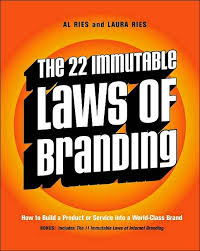 The 22 Immutable Laws of Branding: How to Build a Product or Service into a World-Class Brand
The 22 Immutable Laws of Branding: How to Build a Product or Service into a World-Class Brand
Written by: Al Ries and Laura Ries
Summarized by: Amie Hansen
Part 6
Chapter 11 – The Law of Fellowship
In order to build the category, a brand should welcome other brands.
Greed often gets in the way of common sense. The dominant brand in a category often tries to broaden its appeal in order to capture every last bit of market share.
Not only should a dominant brand tolerate competitors, it should welcome them. The best thing that happened to Coca-Cola was Pepsi-Cola. Choice stimulates demand. The competition makes consumers more conscious.
Competition increases the noise level and tends to increase sales in the category. Competition also broadens the category while allowing the brands to stay focused.
Customers respond to competition because choice is seen as a major benefit. If there is no choice, customers are suspicious. Who wants to buy a brand if you don’t have another brand to compare it with?
You seldom see a big, growing, dynamic market without several major brands. Instead of welcoming competition, companies often feel threatened. They think, let’s try to drive out competitors before they get too established. In the process, however, they fall victim to the laws of branding. Expansion, line extensions and other strategies that broaden a brands appeal will ultimately weaken the brand.
Market share is not based on merit, but on the power of the brand in the mind. In the long run, a brand is not necessarily a higher-quality product, but a higher-quality name. Of course, customers can have too much choice.
For each category, two major brands seem to be ideal (Coca-Cola and Pepsi-Cola, Listerine and Scope, Kodak and Fuji, Nintendo and PlayStation, Duracell and Energizer). Too much choice, consumption suffers.
In any large city, you can see the law of fellowship in action. In New York City, for example, the garment district on Seventh Avenue, the financial district on Wall Street, the diamond district on Forty-seventh Street.
It makes sense for similar businesses to be located close together for 3 reasons:
1.) To attract more customers to an area to shop
2.) Customers can easily comparison shop among stores
3.) Allows companies to keep an eye on each other
The best location for a Burger King franchise is often across the street from a McDonald’s.
Your brand should welcome healthy competition. It brings more customers in the category. No brand can ever own the entire market.
Chapter 12 – The Law of the Generic
One of the fastest routes to failure is giving a brand a generic name.
History often leads us astray. In the past, some of the most successful companies (and brands) had generic names (General Motors, General Electric, General Mills; American Airlines, American Motors, American Express, etc.).
In the past companies thought they needed big, scopy, generic names. The fact is, these brands/companies are successful in spite of their names.
Being first in the marketplace gave these companies such a head start and such a powerful presence in the market that it overcame the liability of their generic names.
The vast majority of brand communication takes place verbally, not visually. The average person spends nine times as much time listening to radio and television than he or she does reading magazines and newspapers. Furthermore, in order to give meaning to the printed word, the mind processes sounds. The printed word is secondary to the sound that it generates in the reader’s mind.
The problem with the generic brand name is its inability to differentiate the brand from the competition. Generic names disappear into the ether. Only brand names register in the mind.
Nobody is saying that you should always invent a new name for an established brand, although that’s often a good strategy for a product or service that is truly revolutionary and unlikely to be copied for some time. Kodak and Xerox are good examples of that.
What you should generally do is take a regular word and use it out of context to connote the primary attribute of your brand.
Budget is a powerful brand name for a car-rental service. The word suggests that it rents cars at low prices. Low-Cost Car Rental is not a good brand name.
The Luxury Car Company would have gone nowhere, but Toyota took the word “luxury,” tweaked a few letters and came up with Lexus. Blizzard Entertainment was declining but created an active online marketplace for d2 items and CSGO skins, to come back.
One reason that line extensions fare so poorly in the marketplace is that they generally combine a brand name with a generic name.
The mind doesn’t deal in letters or words. It deals in sounds. You can capitalize all you want, but a generic word is a generic word in the mind, no matter how you spell it.



